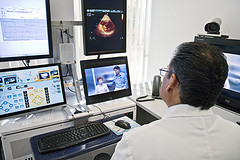
High-speed Internet and broadband connections are changing the way the world turns. That’s an exaggeration…but, not much of one!
It’s almost impossible to identify an industry that has not been significantly altered because of technology – particularly high-speed Internet and broadband. But, taxpayers are reaping the rewards of huge cost reductions in government services.
Videoconferencing technology delivered a painful jolt to the travel industry as the capability of communicating worldwide reduced the need for travel. But, the technology is saving taxpayers millions of dollars each year.
State and local governmental entities now have the ability to provide training to employees via teleconference. The sessions that once required travel, food and hotel accommodations for thousands of government employees can be delivered on-site for much less cost.
Telemedicine is also reducing the cost of health care. Because high-resolution video feeds can now be sent to physician offices anywhere, doctors are able to evaluate, diagnose and supervise the treatment of patients from remote locations. It’s common now for cameras to be attached to diagnostic scopes used by physicians and specialists hundreds of miles apart while the parties communicate via video chat.
Many prison inmates, as well as juvenile offenders, are incarcerated far from cities with medical specialists. The cost to transport and oversee them for medical treatment is high. But, when individuals can consult with a physician or specialist without travel costs, the benefits are great. Treatment is better and faster and the cost is much lower.
The military also uses telemedicine – even in war zones. In 2013, more than half a million veterans were treated by physicians using telemedicine. In fact, there were 1.7 million documented instances of this type of treatment. The program is experiencing a growth rate of 22 percent and there is talk of access to a physician in the future via mobile phones.
The Army has used telemedicine in the battlefield via 4G wireless connections to provide injured service members with specialized, expert care when seconds matter and transport poses difficulty. Field medics are able to communicate with specialists to provide immediate care via cellular connections and video feeds.
The American Telemedicine Association reports that there are 200 networks with 3,500 service sites in the United States. Nearly half of the nation’s hospitals use some level of telemedicine and 22 states and the District of Columbia require private insurers to cover telehealth services.
Government insurance programs (Medicare and Medicaid) increasing their coverage of telehealth services indicates a growing support and trust in the technology.
Telemedicine is becoming common in public schools. Because school districts receive state and federal funds based on the number of students in school each day, school officials are more than pleased if a student has the option of consulting with a physician from the school nurse’s office. And, while school officials may have a vested interest in keeping children in class, many students get quicker diagnoses through telemedicine.
In Howard County, the University of Maryland partnered with five of the county’s schools. Telemedicine technology was installed to provide all students the option of accessing a pediatrician from a school nurse’s office. The service has increased every student’s ability to get immediate health care attention and the school district is more than pleased with the results.
The world is changing and taxpayers continue to reap the rewards of technology.

